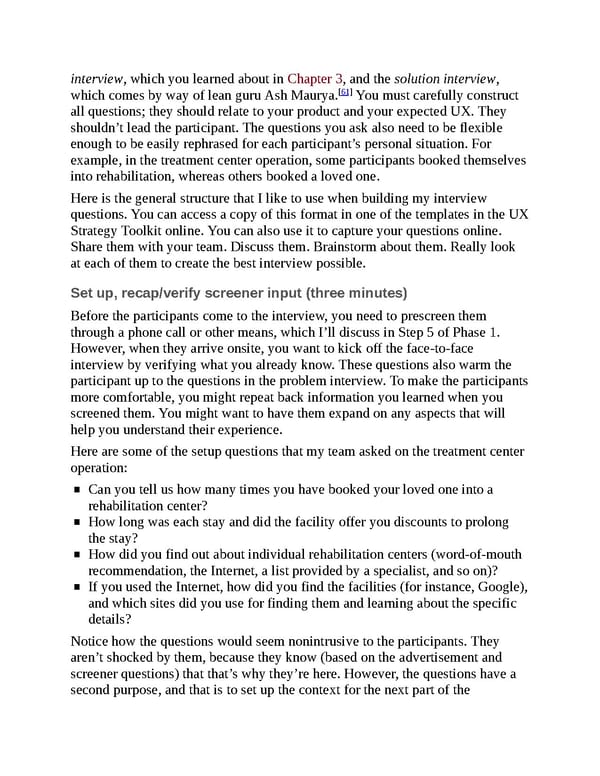interview, which you learned about in Chapter 3, and the solution interview, [61] which comes by way of lean guru Ash Maurya. You must carefully construct all questions; they should relate to your product and your expected UX. They shouldn’t lead the participant. The questions you ask also need to be flexible enough to be easily rephrased for each participant’s personal situation. For example, in the treatment center operation, some participants booked themselves into rehabilitation, whereas others booked a loved one. Here is the general structure that I like to use when building my interview questions. You can access a copy of this format in one of the templates in the UX Strategy Toolkit online. You can also use it to capture your questions online. Share them with your team. Discuss them. Brainstorm about them. Really look at each of them to create the best interview possible. Set up, recap/verify screener input (three minutes) Before the participants come to the interview, you need to prescreen them through a phone call or other means, which I’ll discuss in Step 5 of Phase 1. However, when they arrive onsite, you want to kick off the face-to-face interview by verifying what you already know. These questions also warm the participant up to the questions in the problem interview. To make the participants more comfortable, you might repeat back information you learned when you screened them. You might want to have them expand on any aspects that will help you understand their experience. Here are some of the setup questions that my team asked on the treatment center operation: Can you tell us how many times you have booked your loved one into a rehabilitation center? How long was each stay and did the facility offer you discounts to prolong the stay? How did you find out about individual rehabilitation centers (word-of-mouth recommendation, the Internet, a list provided by a specialist, and so on)? If you used the Internet, how did you find the facilities (for instance, Google), and which sites did you use for finding them and learning about the specific details? Notice how the questions would seem nonintrusive to the participants. They aren’t shocked by them, because they know (based on the advertisement and screener questions) that that’s why they’re here. However, the questions have a second purpose, and that is to set up the context for the next part of the
 UX Strategy: How to Devise Innovative Digital Products that People Want Page 224 Page 226
UX Strategy: How to Devise Innovative Digital Products that People Want Page 224 Page 226